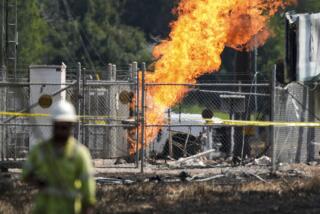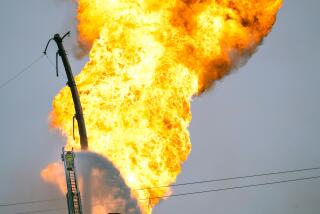Oil platform explodes off Louisiana
Reporting from Atlanta and Los Angeles — The opening scene was all too familiar. Black smoke rising from a burning oil platform in the Gulf of Mexico and workers plucked from the sea. But Thursday’s fire on an oil production facility 100 miles off the Louisiana coast appears to have ended without disaster.
None of the 13 workers on board the platform was injured. The Coast Guard found no evidence of an oil leak, and by Thursday afternoon the fire was out.
The accident — the cause is unknown and under investigation — happened a little more than four months after BP’s Deepwater Horizon rig blowout, which killed 11 workers and resulted in the largest offshore oil spill in U.S. history.
Thursday’s fire sent shudders along the Gulf Coast, but Houston-based Mariner Energy Inc. reported that it was able to shut in the wells connected to the oil and gas platform, averting leaks.
“Automated shutoff equipment on the platform safely turned off the flow of oil and gas from the platform’s seven producing wells before the fire occurred and the crew evacuated,” the company said in a news release.
Louisiana Gov. Bobby Jindal said the company told officials that the fire burned an oil product stored on the platform — unlike the BP drilling rig blaze, which was fed by an uncontrollable gush from its blown-out well.
“That’s a very important point,” Jindal said.
Thursday’s accident occurred farther west than the BP blowout, on an oil and gas platform in shallow water south of Terrebonne Bay, according to the Bureau of Ocean Energy Management, Regulation and Enforcement.
Coast Guard officials said they received a call at 9:18 a.m. Central time that the platform was engulfed in flames. Crews on a nearby oil facility reported seeing an explosion on the platform.
The 13 workers, wearing red floatation suits, apparently leaped into the water, which is about 340 feet deep. They were picked up by a supply vessel and flown by helicopter to an onshore hospital. Mariner said were no reported injuries.
The company focuses on oil and natural gas exploration and production in the gulf. Among the gulf’s outer-continental shelf operators, it ranks as the eighth-largest in natural gas production and 24th in oil production.
During the last week of August, production on the platform, located in a lease area called Vermilion Block 380, averaged about 9.2 million cubic feet of natural gas per day and 1,400 barrels of oil and condensate.
The Vermilion platform was the scene of a drilling accident in 2008 that seriously injured a crew member. The company has also been involved in more than a dozen offshore accidents in the gulf in the last four years, including at least four fires and a well blowout, according to the federal Bureau of Ocean Energy Management records.
In Washington, reaction to the accident was swift. Within hours of the fire, House Energy and Commerce Committee leaders sent a letter to Mariner’s chief executive, asking for a briefing on the incident and its possible causes.
“In the wake of the BP catastrophe, this is an extremely disturbing event,” said energy committee chairman Rep. Henry A. Waxman (D-Beverly Hills), who has led an investigation into the BP spill. “I call on the administration to immediately redouble safety reviews of all offshore drilling and platform operations in the gulf and take all appropriate action to ensure safety and protection of the environment.”
Randall Luthi, president of the National Ocean Industries Assn., acknowledged that Thursday’s incident, just four months after the Deepwater Horizon explosion, “hits everyone’s radar.” But he cautioned in a statement that “we must keep things in perspective and remember that accidents happen in almost any occupation.”
The Mariner fire could give new impetus to legislation that would strengthen offshore drilling safeguards. The House passed a sweeping bill after the BP spill, but it stalled in the Senate.
The explosion also revved up support for the Obama administration’s moratorium on deep-water drilling, which the oil industry has been fighting. The ban doesn’t cover the Mariner platform, which is located in shallow waters and is not a drilling operation.
“We find it ironic that the explosion happened one day after the American Petroleum Institute, the oil industry’s trade association, held a rally in Houston, Port Arthur and Corpus Christi, Texas, to lift the moratorium on deep-water drilling in the gulf,” said United Steelworkers International Vice President Gary Beevers in a statement. “Instead of holding political protests, the API and the industry should be helping the government ensure all the rigs are safe to operate so the moratorium can be removed sooner.”
Kieran Suckling, executive director of the Tucson-based Center for Biological Diversity, said that “today’s news comes as no surprise. Offshore drilling in the Gulf of Mexico is like playing Russian roulette. It’s not a matter of if something will go wrong; it’s a matter of when.”
The administration has said it plans to keep the moratorium in place until Nov. 30 at the latest.
Industry groups tried to fend off any effort to use Thursday’s incident to limit new drilling.
Jim Noe, executive director of the Shallow Water Energy Security Coalition, said in a statement: “We should wait for the facts before we use what happened today on a production platform as a reason to stop offshore drilling, especially when the incident didn’t have anything to do with offshore drilling. The fire occurred a production platform, not a drilling rig, and no drilling operations were involved.”
The BP well has not leaked since mid-July, when it was capped. But the government and BP are still working on the ultimate plug of that well, which is expected to be completed sometime after Labor Day.
Initially Thursday, there were reports of a sheen of “medium” oil 100 feet wide and 1 nautical mile long near the platform. But Coast Guard officials later said none had been detected.
richard.fausset@latimes.com
bettina.boxall@latimes.com
Fausset reported from Atlanta and Boxall reported from Los Angeles
Times staff writers Julie Cart and P.J. Huffstutter in Los Angeles, Richard Simon in Washington and Kim Geiger in the Washington bureau contributed to this report.
More to Read
Sign up for Essential California
The most important California stories and recommendations in your inbox every morning.
You may occasionally receive promotional content from the Los Angeles Times.











